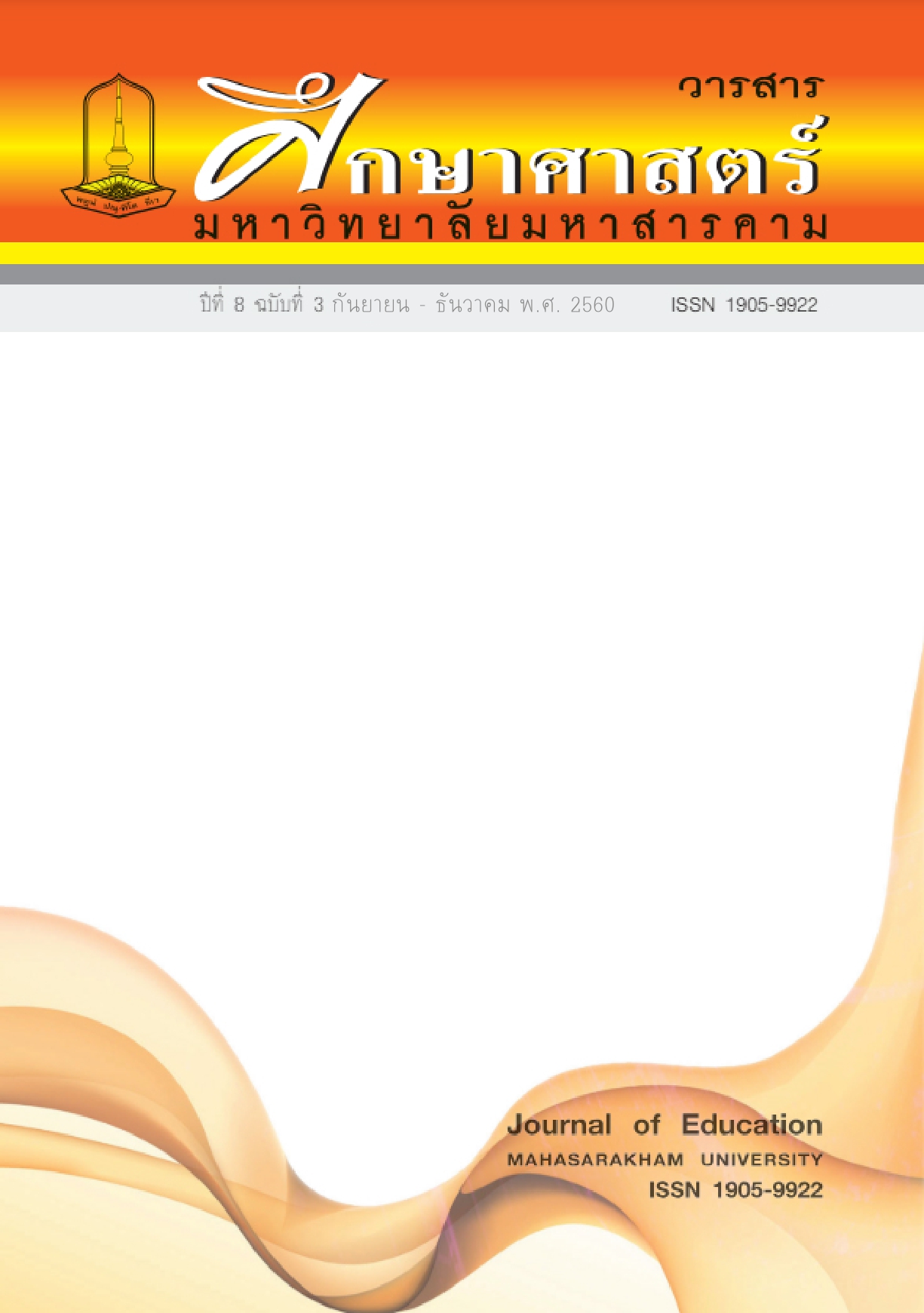Developing the Guidelines of Learning Management for Mathematics teachers under the Office of Secondary Educational Service Area 23
Main Article Content
Abstract
This research purposes were 1) to synthetic elements and indicators of the mathematics learning management 2) to study current situations the desirable under the Office of Secondary Educational Service Area 23. 3) To develop the guidelines of learning management for mathematics teachers. The research was designed into 3 phrases. Phrase 1 was to study factors and indicators of the mathematics learning management. Phrase 2 was to study the current and desirable situations of the mathematics learning management. Phrase 3 was to develop the guidelines of learning management for mathematics teachers. Samples in phrase 1 were 5 experts. Phrase 2 were150 mathematics teachers randome by simple random sampling. Phrase 3 were 5 experts. The research instruments were the questionnaire with 5 rating scale and the appropriate evaluation form. The data were analyzed by percentage, mean, standard deviation and Modified Priority Needs Index.
The research results were as followed: 1. There were 5 elements and 20 indicators of the mathematics learning management which consisted of: 1) knowledge and understanding about teaching mathematics including 5 indicators 2) knowledge in priciples of mathematics learning management including 4 indicators 3) design and learning activities including 5 indicators 4) the use of learning materials including 3 indicators and 5) the measurement and evaluation of learning mathematics including 3 indicators. Both elements and indicators were evaluated at the highest level of appropriateness. 2. The current situations of the mathematics learning management under the Office of Secondary Educational Service Area 23 as the whole and each elements were at the high level. 3. Developing the Guidelines of learning management for mathematics teachersunder the Office of Secondary Educational Service Area 23. The analysis of Modified Priority Needs Index was found the ranking of needs from highest to the lowest were 1) design and learning activities 2) the measurement and evaluation of learning mathematics 3) the use of learning materials 4) knowledge in priciples of mathematics learning management and 5) knowledge and understanding about teaching mathematics.
The evaluation of the guidelines of learning management for mathematics teachers were at the highest level of appropriateness and high level of feasibility.
Downloads
Article Details
References
กรมวิชาการ. (2545). หลักสูตรการศึกษาขั้นพื้นฐาน พุทธศักราช 2544. กรุงเทพ ฯ: โรงพิมพ์องค์การรับส่งสินค้าและพัสดุภัณฑ์,
กระทรวงศึกษาธิการ. (2551). หลักสูตรแกนกลางการศึกษาขั้นพื้นฐาน พุทธศักราช 2551. กรุงเทพ ฯ: โรงพิมพ์ชุมนุมสหกรณ์การเกษตรแห่งประเทศไทย,
ชมนาด เชื้อสุวรรณทวี. (2542). เอกสารประกอบการสอนวิชาการสอนคณิตศาสตร์. กรุงเทพ ฯ: มหาวิทยาลัยศรีนครินทรวิโรฒประสานมิตร,
มหาวิทยาลัยราชภัฏวไลยอลงกรณ์ ในพระบรมราชูปถัมภ์. (2553). คู่มือการจัดระบบการเรียนการสอนที่ยึดผู้เรียนเป็นศูนย์กลางการเรียนรู้. กรุงเทพ ฯ: โรงพิมพ์เทียนวัฒนาพริ้นท์ติ้ง,
วัชรี กาญจน์กีรติ. (2559). การจัดการเรียนรู้คณิตศาสตร์ [Online]. เข้าถึงได้จาก: http://www.phichsinee.cmru.ac.th/develop/admin/mydownload/file/2104131 91152.PDF. สืบค้นเมื่อวันที่ 1 กรกฎาคม.
มะลิวัน สมศรี. (2558). การพัฒนาคู่มือพัฒนาสมรรถนะทางวิชาการของครูผู้สอนในสถานศึกษา สังกัดสำนักงานเขตพื้นที่การศึกษาประถมศึกษาอุดรธานี เขต 2. วิทยานิพนธ์ กศ.ม. มหาสารคาม: มหาวิทยาลัยมหาสารคาม,
โรงเรียนบ้านม่วงพิทยาคม. (2559). คู่มือการบริหารกลุ่มงานวิชาการ. คำ สั่งโรงเรียนบ้านม่วงพิทยาคม ปีการศึกษา 2559.
บุญชม ศรีสะอาด. (2554). การวิจัยการศึกษาเบื้องต้น. พิมพ์ครั้งที่ 9. กรุงเทพ ฯ: สุวีริยาสาส์น.
พิศมัย ศรีอำไพ. (2545). รายงานการวิจัยเรื่องเปรียบเทียบผลสัมฤทธิ์ทางการเรียนวิชาคณิตศาสตร์เรื่องบทประยุกต์ชั้นประถมศึกษาปีที่ 6 ระหว่างกลุ่มที่เรียนโดยการจัดกิจกรรมการเรียนการสอนตามวิธีของอุไรวรรณ ธนยั่งยืน กับกลุ่มที่เรียนโดยการจัดกิจกรรมการเรียนการสอนที่เน้นการค้นพบโดยพลังกลุ่ม. มหาสารคาม: ภาควิชาหลักสูตรและการสอน ณะศึกษาศาสตร์ มหาวิทยาลัยมหาสารคาม,
วชรพร ศรีไทย. (2554). สมรรถนะครูคณิตศาสตร์ที่สอนระดับมัธยมศึกษา ตามทัศนะของนักเรียนช่วงชั้นที่ 4 ในโรงเรียนสังกัดสำนักงานเขตพื้นที่การศึกษาอุดรธานี เขต 1. วิทยานิพนธ์ กศ.ม. มหาสารคาม: มหาวิทยาลัยมหาสารคาม,
เวชฤทธิ์ อังกนะภัทรขจร. (2553). “การสอนแนะให้รู้คิด (Cognitively Guided Instruction: CGI): รูปแบบหนึ่งของการจัดการเรียนรู้คณิตศาสตร์.” วารสารศึกษาศาสตร์ ปีที่ 21(1) ตุลาคม 2552- มกราคม 2553): หน้า 1-11.
สำนักงานเขตพื้นที่การศึกษามัธยมศึกษาเขต 23. (2558). แผนปฏิบัติการประจำปี 2558. สกลนคร: สำนักงานเขตพื้นที่การศึกษามัธยมศึกษาเขต 23.
สำนักงานเลขาธิการสภาการศึกษา. (2547). คุรุสภา พัฒนาครู พัฒนาชาติ ใบอนุญาตประกอบวิชาชีพครู. กรุงเทพ ฯ: โรงพิมพ์เดือนตุลาคม,
ทิศนา แขมมณี. (2550). ศาสตร์การสอน: องค์ความรู้เพื่อการจัดการกระบวนการเรียนรู้ที่มีประสิทธิภาพ. พิมพ์ครั้งที่ 5. กรุงเทพฯ: สำนักพิมพ์แห่งจุฬาลงกรณ์มหาวิทยาลัย.
อรุณี ศรีวงษ์ชัย. (2551). การเปรียบเทียบผลสัมฤทธิ์ทางการเรียนความสามารถในการให้เหตุผลและเจตคติต่อการเรียนคณิตศาสตร์ของนักเรียนชั้นมัธยมศึกษาปีที่ 3 ระหว่างการจัดกิจกรรมการเรียนรู้แบบสืบเสาะกับการจัดกิจกรรมการเรียนรู้แบบปกติกลุ่มสาระการเรียนรู้คณิตศาสตร์ เรื่อง ระบบสมการเชิงเส้น. วิทยานิพนธ์การศึกษามหาบัณฑิต สาขาวิชาหลักสูตรการสอน: มหาวิทยาลัยมหาสารคาม,
Perrine, Vicki. (2001). Effect of a Problem-Solving-Based Mathematics Course on the Proportional Reasoning of Preservice Teachers. Dissertation Abstracts International. Retireved February 15,2008, from http://wwwlib.uni.com/dissertations/fullcit/3006601.
Swain, Jon and Malcolm Swan. (2009). “Teachers Attempts to Integrate Research-Based Principles Into the Teaching of Numeracy with Post-16 Learner,” Research in Post - Compulsory Education. 14(1): 75-92 ; March,


